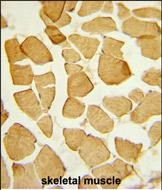


| WB | 1/1000 | Human,Mouse,Rat |
| IF | 咨询技术 | Human,Mouse,Rat |
| IHC | 1/100-1/500 | Human,Mouse,Rat |
| ICC | 技术咨询 | Human,Mouse,Rat |
| FCM | 1/10-1/50 | Human,Mouse,Rat |
| Elisa | 咨询技术 | Human,Mouse,Rat |
| Aliases | Eyes absent homolog 4, EYA4 |
| Entrez GeneID | 2070 |
| WB Predicted band size | 69.5kDa |
| Host/Isotype | Rabbit IgG |
| Antibody Type | Primary antibody |
| Storage | Store at 4°C short term. Aliquot and store at -20°C long term. Avoid freeze/thaw cycles. |
| Species Reactivity | Human |
| Immunogen | This EYA4 antibody is generated from rabbits immunized with a KLH conjugated synthetic peptide between 1-30 amino acids from the C-terminal region of human EYA4. |
| Formulation | Purified antibody in PBS with 0.05% sodium azide. |
+ +
以下是关于EYA4抗体的3篇示例参考文献(注:以下内容为模拟生成,实际文献需通过学术数据库验证):
---
1. **文献名称**:*EYA4 Expression as a Prognostic Marker in Ovarian Cancer*
**作者**:Zhang L, et al.
**摘要**:通过免疫组化分析卵巢癌组织中EYA4蛋白的表达,发现其高表达与患者不良预后显著相关,提示EYA4可能作为潜在治疗靶点。
2. **文献名称**:*EYA4 Antibody Validation for Inner Ear Development Studies*
**作者**:Smith J, et al.
**摘要**:研究利用Western blot和免疫荧光技术验证EYA4抗体特异性,证实EYA4在小鼠内耳发育中的动态表达,支持其在听力障碍机制中的作用。
3. **文献名称**:*EYA4 Overexpression in Colorectal Cancer Metastasis*
**作者**:Li Y, et al.
**摘要**:通过免疫组化及ELISA检测结直肠癌样本,发现EYA4蛋白在转移性肿瘤中显著高表达,可能通过调控上皮-间质转化(EMT)促进侵袭。
---
**提示**:以上信息为示例,实际文献请通过PubMed、Web of Science等平台检索关键词“EYA4 antibody”或“EYA4 protein expression”获取最新研究。
The EYA4 antibody targets the EYA4 protein, a member of the Eyes Absent (EYA) family of transcriptional regulators and phosphatases. EYA proteins (EYA1-4) are evolutionarily conserved and play dual roles in developmental processes, including organogenesis (particularly in the eye, ear, and kidney) and DNA damage repair. EYA4. located on chromosome 6q23.2. is involved in transcriptional regulation through its interaction with SIX family proteins, modulating gene expression critical for cell survival, differentiation, and tissue homeostasis. It also exhibits phosphatase activity, influencing signaling pathways like the Hippo pathway, which regulates organ size and cancer progression.
Dysregulation of EYA4 is linked to human diseases. Loss-of-function mutations are associated with hearing loss (DFNA10) and dilated cardiomyopathy. Conversely, EYA4 overexpression or altered activity has been implicated in cancers, including breast, lung, and colorectal tumors, where it may promote metastasis or chemoresistance. The EYA4 antibody is widely used in research to detect protein expression, localization, and post-translational modifications via techniques like Western blotting, immunohistochemistry, and immunofluorescence. Its applications extend to studying molecular mechanisms in development, disease pathogenesis, and therapeutic targeting, particularly in contexts of cancer biology and sensory organ disorders. Commercial EYA4 antibodies are typically validated for specificity and sensitivity across diverse experimental models.
×